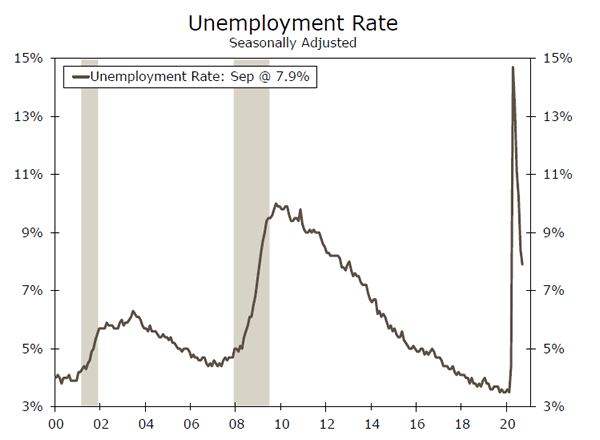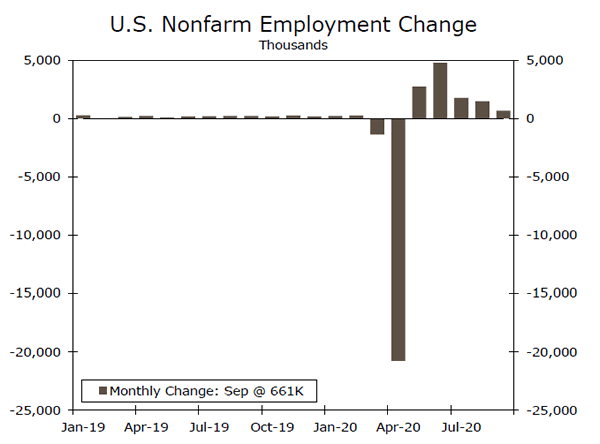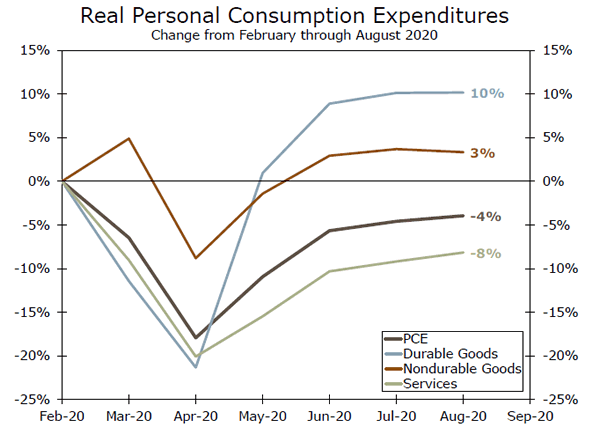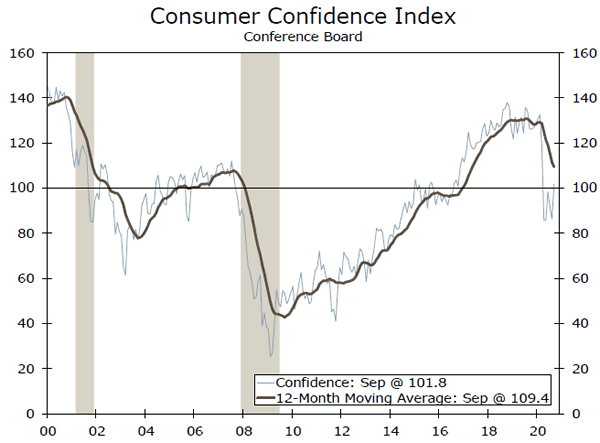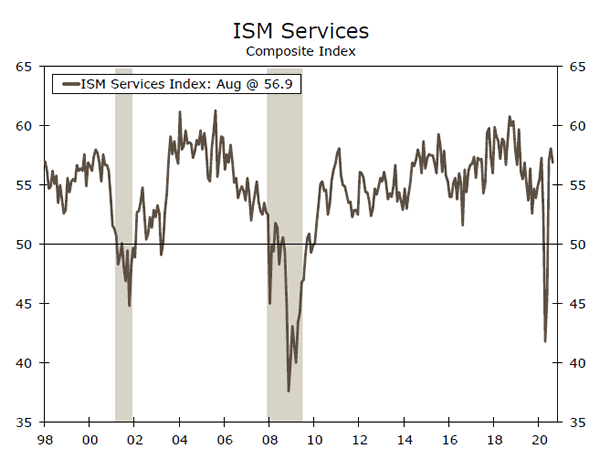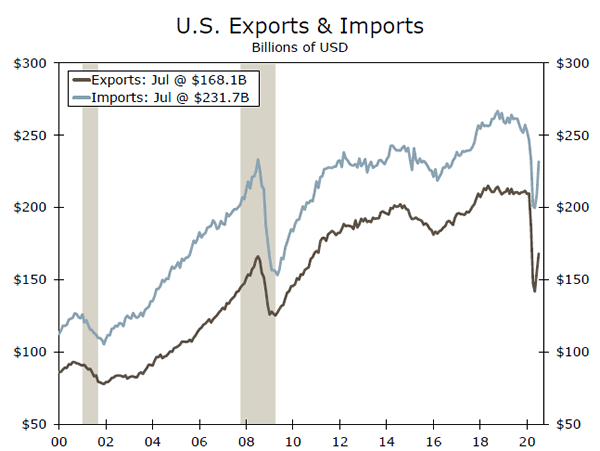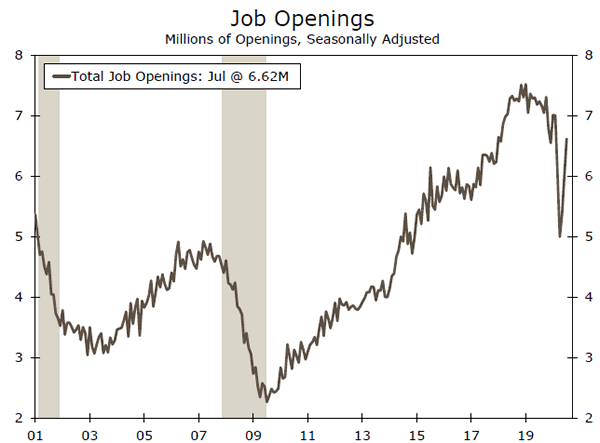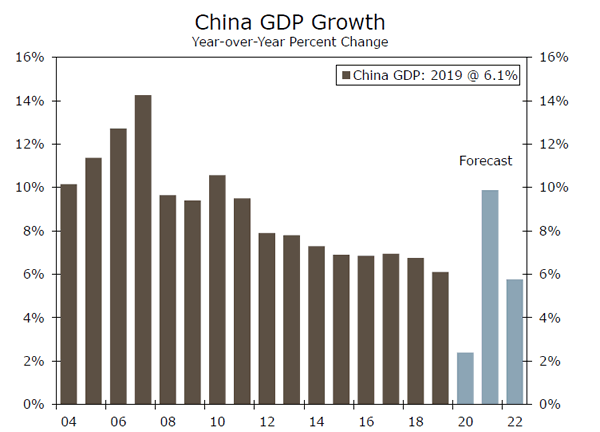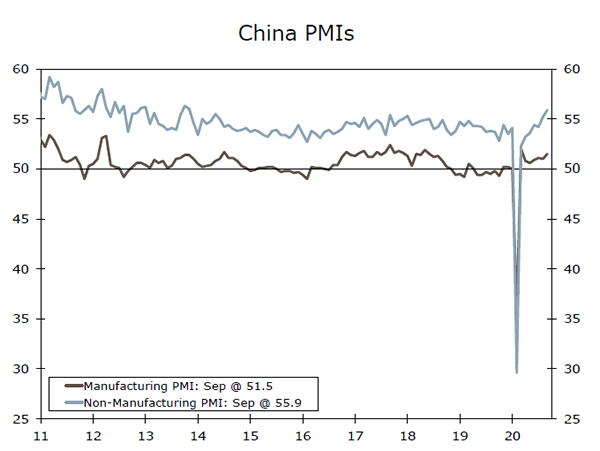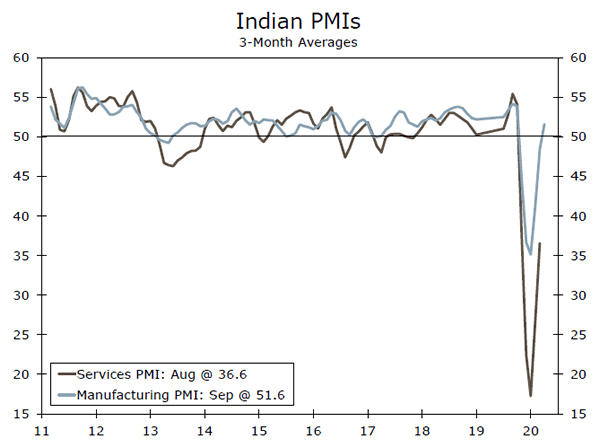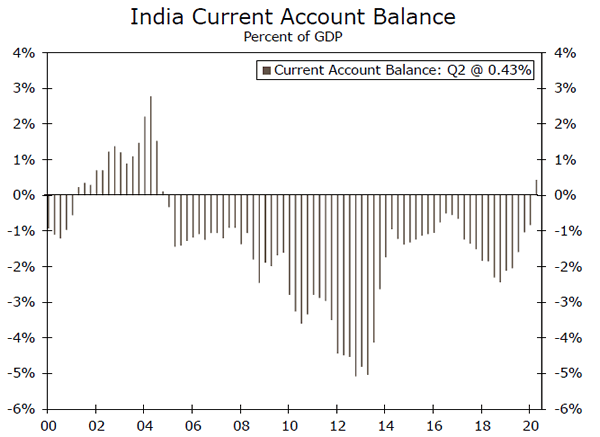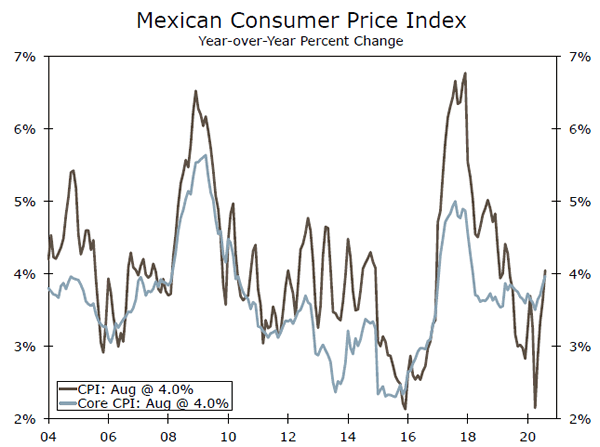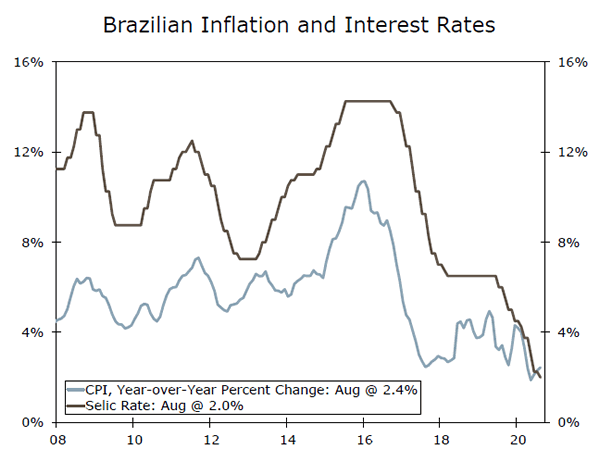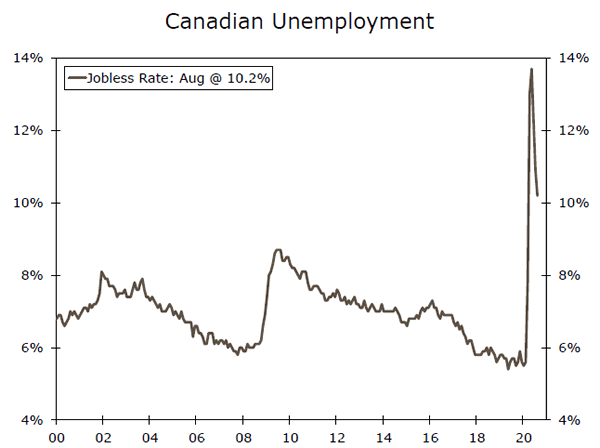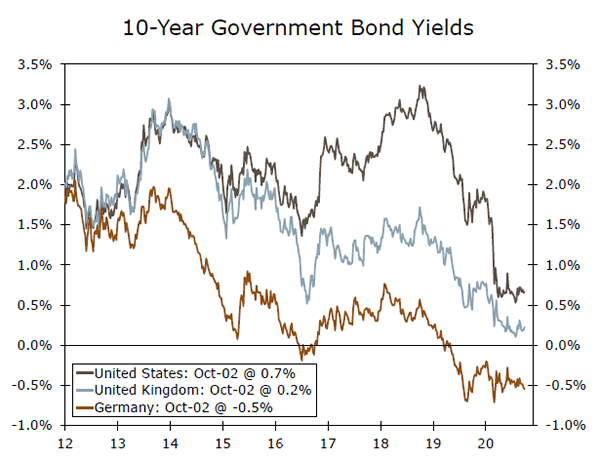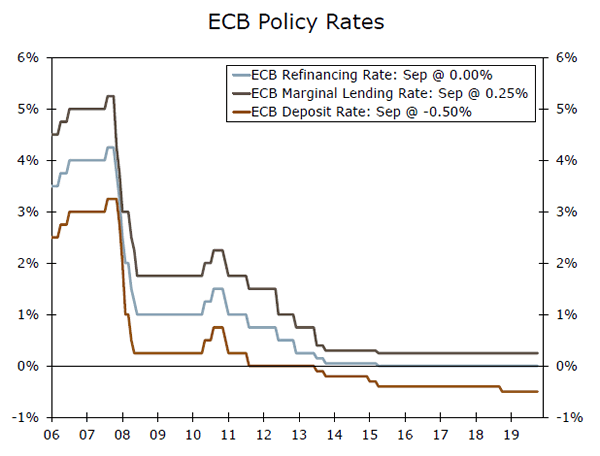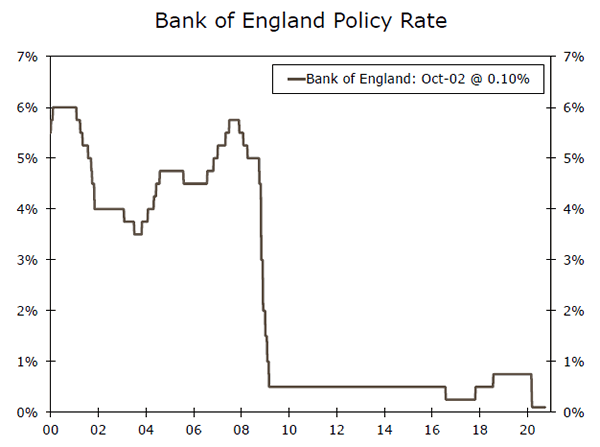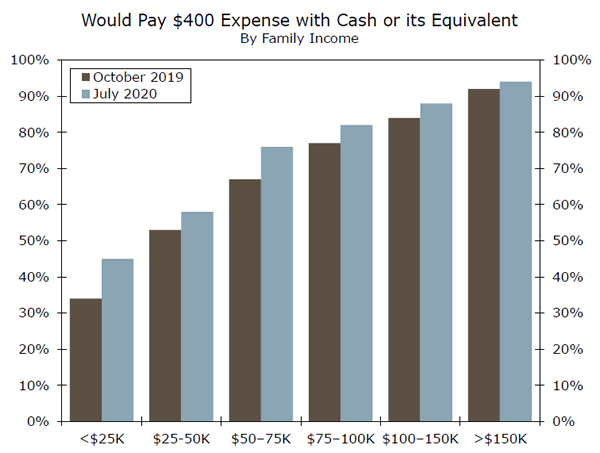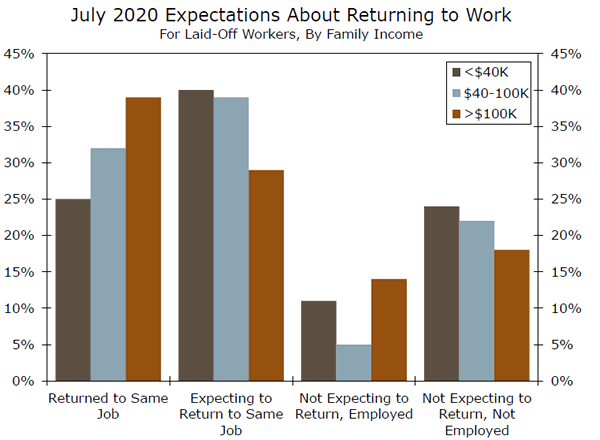U.S. Review
Recovery Keeps Trudging Along
- In what was a jam-packed week of economic data, the jobs report, prospects of additional fiscal stimulus and the president’s positive COVID-19 test result commanded markets’ attention.
- Nonfarm employers added 661K jobs in September. But with layoff announcements coming from household-name companies this week, attention has already shifted to the tenuous labor market recovery ahead.
- Personal incomes faltered in August, due almost entirely to the expiration of supplemental unemployment benefits at the end of July. Personal spending, however, eked out another gain.
Recovery Keeps Trudging Along
The labor market recovery continues to slow. Employers added a net 661K jobs in September, which would signify a marked improvement in ordinary times, but it is less than half the number of jobs added in August. Further, while the unemployment rate slid to 7.9% twice as many people left the labor force than became employed. In short, the labor market continued its recovery, but attention has already shifted to the tenuous outlook. See our jobs report for a comprehensive review of the release.
Recent layoff announcements among household-name companies highlight that despite the torrid pace of economic growth in recent months, activity still remains well below pre-virus levels in many industries. With no end to the pandemic in sight, businesses are adjusting their staffing needs, which threatens the recovery’s gains, especially with fading fiscal support to both businesses and the unemployed. With millions of American’s still in precarious financial situations, prospects of additional stimulus remained top of mind this week. But, an additional fiscal relief package remained unsettled and we still believe it as unlikely another stimulus bill will get passed prior to the presidential election in November.
Fiscal stimulus has been vital in shoring up lost income during the pandemic, providing households and businesses with a bridge to the other side of the crisis. But with this support fading many have feared the rug is being pulled out from underneath the fledgling economic recovery. For households, the expiration of federal supplemental unemployment benefits at the end of July caused much hand-wringing regarding the looming hurdle for consumer spending and thereby possible fall out for the economic rebound more generally. Such concerns are not off-base as millions of American’s remain unemployed and continue to rely on benefits. As expected, personal incomes declined 2.7% in August, which was due almost entirely to the decline in unemployment benefits. It remains to be seen if consumers will meaningfully reduce spending, but even with millions not receiving the extra stimulus income in August, spending still rose 1.0%.
The consumer spending details continue to reflect the broader downturn, with industries concentrated in goods performing well but services industries still reeling. We’ve pointed to elevated savings as a key reason that we’ve seen a complete V-shaped recovery in durable goods consumption. The rebound in services spending is expected to take longer to unfold as economic limitations due to the virus remain in place and many services remain offline or reduced in scale. Simply consumers’ inability to spend, or what we’ve denoted as “forced thrift,” will also play a part in preventing a full-rebound in services spending for quite some time. In light of this dynamic, the confidence data have become all the more important. The latest consumer confidence survey from the Conference Board revealed the largest increase in confidence in 17 years in September. It is encouraging for the consumer outlook that we haven’t seen confidence falter in the immediate aftermath of the supplemental unemployment benefits expiration.
But, in what was the COVID test heard around the world, the news that President Trump tested positive for COVID-19 will likely dampen both consumer and market sentiment. Despite the U.S. economy being on the road to recovery, the President’s diagnosis serves as the latest reminder that the fate of the economic rebound is still highly dependent on the trajectory of the virus.
U.S. Outlook
ISM Services Index • Monday
The re-opening bump in the service sector appears to be fading somewhat. The headline services ISM came in at 56.9 during August, down slightly from the 58.1 reading in July. For context, the overall index plummeted to 41.8 in April and returned to expansion territory in June as restrictions on businesses were loosened.
The underlying details point to some additional slowing ahead. The business activity subcomponent fell to 62.4 from 67.2, a sharper decline than the topline index. There was also a significant drop in new orders, which declined more than 10 points to 56.8.
Encouragingly, the employment subcomponent improved by almost six points, but the 47.9 reading reached during August still only indicates that the pace of service sector layoffs have merely slowed. Considering that COVID-19 continues to circulate and many restrictions on close-contact services remain in place, we expect services activity to continue to moderate in coming months.
Previous: 56.9 Wells Fargo: 56.2 Consensus: 56.3
Trade Balance • Tuesday
The US trade deficit widened to -$63.6 billion in July, the largest since 2008. The wider deficit during the month occurred as growth in imports (+10.9%) outpaced exports (+8.1%). The relative strength in imports lately has been primarily fueled by soaring consumer demand for durable goods. In fact, demand for imported goods has been so strong that the “goods” trade deficit expanded to the largest on record during the month (-$80.9 billion).
Exports have not turned up quite as quickly as imports, as the global growth environment has struggled to find secure footing. There has also been a resurgence of new COVID-19 cases in Europe, which could weigh heavily on exports in coming months. On the imports side of the ledger, the pace of improvement may also slow as domestic case counts remain elevated and the summer bounce in consumer activity looks to be fading heading into the fall. Overall, a wider deficit means trade will be a drag on GDP growth in Q3.
Previous: -$63.6B Wells Fargo: -$66.6B Consensus: -$66.1B
JOLTS Job Openings • Tuesday
The Job Opening and Labor Turnover Survey (JOLTS) will be released by the BLS on Tuesday. During July, the number of job openings rose to 6.62 million from 6.0 million, the third consecutive monthly increase. This outcome exceeded consensus estimates, but there is still quite a bit of road ahead to get back to the 7.24 million openings hit during the same time last year. Furthermore, there are still over twice (2.46) as many unemployed as there are vacant positions.
Indications of the current state of the labor market have taken on renewed importance lately as employment growth appears to be cooling down and a potential new round of fiscal relief is debated. We do not forecast the result of the JOLTS, but the consensus forecast calls for a slight moderation in job openings during August. This would be consistent with the slowing trajectory of employment growth seen in the more widely followed payroll survey.
Previous: 6.6 million Consensus: 6.5 million
Global Review
China Continues to Lead the Global Recovery
- China’s economy continues to rebound from the COVID-19 shock and lead the global economic recovery. This week, the manufacturing and non-manufacturing PMIs outperformed relative to expectations, providing additional evidence of a more robust economic recovery in China.
Economic and Sentiment Data in India Show Life
- This week, India’s manufacturing PMI recorded one of the steepest rises on record, jumping to 56.8 in September, a noteworthy rise from August. In addition, India’s current account as a percentage of GDP flipped to a surplus in Q2, the first quarterly surplus since 2005.
China Leading the Global Recovery
Following a contraction in Q1, we have highlighted China’s strong economic recovery for some time now. Activity and mobility have essentially returned to pre-COVID levels and the broader economy continues to demonstrate that the worst of COVID-19 is behind China. This week, more evidence of China’s recovery presented itself as the manufacturing and non-manufacturing PMIs outperformed consensus expectations. As far as the manufacturing, the PMI rose to 51.5 in September, up from 51.0, against expectations for a more modest rise to 51.3. On the nonmanufacturing side, the non-manufacturing PMI rose to 55.9. The rise in the non-manufacturing PMI is especially noteworthy as consensus forecasts were calling for a decline in September. Outperformance of the manufacturing and non-manufacturing PMIs reinforce our view that China is leading the global economic recovery. As of now, we forecast China to be one of the only major economies to record positive growth this year and recently revised our annual GDP forecast for China higher. We currently forecast China to grow around 2.4% this year, and while uncertainties exist related to the U.S. election and trade with the U.S., we believe risks around our forecast are relatively balanced.
India’s Economy Showing Modest Signs of Life
The COVID-19 crisis has been particularly noticeable in India, both from an economic perspective as well as a health and human services perspective. As of now, India is the second-most infected country in the world, with close to 6.5M confirmed COVID-19 cases. The country has struggled to contain the spread of the virus and has not had much success in flattening the confirmed cases curve over the last six months despite lockdown protocol implemented earlier in the year. As a result of one of the strictest nationwide lockdowns in the world, India’s economy experienced a significant contraction in Q2, losing close to 25% of its economic activity in just three months. With mobility and most activity indicators still subdued, the prospects for India’s economy are somewhat muted for this year and early next year. With that said, India’s manufacturing PMI rose to 56.8 in September, a notable rise from 52.0 a month earlier. Also this week, India’s current account recorded a higher surplus than initially estimated in Q2, close to $19.8B. As a percent of GDP, India’s current account swung into a surplus of 0.43%, the first quarterly surplus as a percent of GDP since the end of 2004.
Improvements to the manufacturing PMI and current account balance are certainly encouraging; however, we are hesitant to make any upward revisions to our annual 2020 GDP forecast for India at this time. We still believe multiple imbalances within the economy; in particular, the health of India’s banking sector and a lack of new credit extension will place restrictions on this year’s growth prospects. The policy response to the COVID-19 induced slowdown has also been lackluster, with most of the stimulus provided by the Reserve Bank of India rather than the Modi administration. As of now, we forecast a 9.3% contraction in 2020, and unless more evidence of a recovery or more fiscal stimulus presents itself, our forecast is unlikely to change materially.
Global Outlook
Mexico CPI Inflation • Thursday
After a sharp decline earlier in the year, CPI inflation in Mexico has been on the rise over the past few months. In August, inflation topped 4%, the upper bound of the central bank’s inflation target, and inflation expectations have continued to push higher. Part of the reason for the rise has been a modest recovery in oil prices, while a slight pickup in consumer activity has also helped price growth. Inflation has been a key factor in the central bank’s assessment of monetary policy, especially at its latest meeting in September. Most recently, policymakers discussed the rise in inflation and what it means for policy rates in Mexico. While the central bank opted to cut interest rates 25 bps in September, we believe the rise in inflation should keep the central bank on hold for the time being. Should inflation again move higher in September, we believe this gives the central bank more rationale to keep policy rates on hold, which could result in a stronger currency in the short-term.
Previous: 4.05%
Brazil Inflation • Friday
The Brazilian economy has come under pressure over the course of this year; however, the last few months have suggested the downturn may not be as severe as initially expected. High frequency indicators have rebounded, while interest rate cuts from the Brazilian Central Bank and fiscal stimulus from the government should aid the recovery going forward. Along with economic indicators, inflation has also started to pick up over the past few months. IPCA inflation, Brazil’s primary gauge of price growth, fell to 1.88% year-over-year in May; however, it moved up to 2.44% year-over-year in August. Part of the uptick in inflation is a result of improved consumer spending activity as well as a significantly weaker Brazilian currency. As mentioned, easier monetary from the central bank has also likely contributed to the pick up in prices. While the central bank may be pausing its easing cycle, the pass through to inflation from lower policy rates has probably not fully materialized and we expect IPCA to move higher.
Previous: 2.44% Consensus: 3.02%
Canada Unemployment Rate • Friday
The Canadian economy, in particular the labor market, has shown signs of a quicker-than-expected recovery lately. As the spread of COVID-19 gained momentum in March and April, Canadian companies opted to displace many workers leading to a sharp increase in the nation’s unemployment rate. Since then, Canada has been able to contain the spread of the virus much more effectively than other G10 countries, and in turn, has been able to reopen parts of the economy and bring back employees. As a result, the unemployment rate has fallen to 10.2% from around 13.7% in May, while the Canadian economy has been able to bring back jobs at a relatively strong pace. In March and April combined, the Canadian economy lost close to three million jobs; however, over the past four months, close to two million of those lost jobs have been recreated. Going forward, we expect the labor market to continue to improve and for the jobless rate to continue to tick lower in September.
Previous: 10.2%
Point of View
Interest Rate Watch
Outlook for Foreign Rates
The yield on the 10-year U.S. Treasury security, which plunged earlier this year as COVID cases in the United States began to shoot higher, remains at extraordinarily low levels (top chart). Not only does the uncertain outlook give investors reason to seek the safe haven of U.S. Treasury securities, but expectations of continued accommodation by the Federal Reserve for the foreseeable future also keeps downward pressure on Treasury yields.
Moreover, long-term interest rates in most foreign economies also remain at extraordinarily low levels. For example, the yield on the 10-year government bond in the United Kingdom is hovering just above 0% at present. The yield on the comparable security in Germany remains in negative territory, where it has been for more than a year. Due to the global nature of capital flows, it’s hard to envision a significant rise in long-term U.S. interest rates if comparable rates in major foreign economies remain depressed.
In that regard, we expect that central banks in most major foreign economies will refrain from raising policy rates for years, which should keep long-term rates in those economies well-anchored. The ECB likely will not lift its main policy rate, which has been maintained at 0.00% for around five years, anytime soon (middle chart). The Bank of England (BoE) slashed its main policy rate to only 0.10% earlier this year when the pandemic more or less brought the U.K. economy to a standstill. As in the case of the ECB, the BoE seem likely to keep rates on hold for quite some time.
Some market participants even look for the BoE to follow the ECB by cutting rates into negative territory. These expectations were bolstered by the minutes of the last policy meeting, which noted that the Monetary Policy Committee (MPC) had discussed the implications of going negative. However, BoE Governor Bailey splashed some cold water on that notion this week by saying “we aren’t there at the moment” regarding negative rates. In our view, it would take some combination of another lockdown and/or a “hard” Brexit to induce the MPC to go negative.
Credit Market Insights
Main Street Lending Program Update
The Federal Reserve’s recent supplementary Senior Loan Officer Opinion Survey suggests that banks are reluctant to utilize the Main Street Lending Program (MSLP). Over 70% of respondents noted that MSLP loans accounted for less than 2.5% of their total commercial & industrial loan business. Furthermore, a majority expect that their willingness to extend MSLP loans will stay the same over the next three months.
The survey showed that banks found a variety of the program’s requirements as overly restrictive for borrowers and unattractive for lenders. On the client side, banks commonly stated that the MSLP’s debt to EBITDA threshold was too low for many qualified borrowers. Significantly, over 50% of banks rated this requirement as a “very important” reason for MSLP loan rejection. Meanwhile, on the lender side, a major fraction of banks indicated that the loss sharing covenant (in the event of a default) was too uncertain.
The Fed designed the MSLP to support the flow of credit to small and medium-sized businesses during this period of financial strain. The program specifically targets businesses that are too large to qualify for the Paycheck Protection Program (PPP). Unlike the PPP, the MSLP has gotten off to a very slow start. Since its official kickoff in July, about $2B in Main Street lending has been approved—a far cry from the program’s $600B capacity. There is still time, however, as the Fed’s lending facilities are not set to expire until December 31.
Topic of the Week
Overall Economic Well-Being Results Improve
The economy may be on the road to recovery, but that is cold comfort to millions of Americans who remain in precarious financial situations. The Federal Reserve Board’s latest report on the Economic Well-Being of U.S. Households provided a snapshot of how households have fared in the wake of the pandemic. The results reflected improvement in consumers’ financial security, with the share of respondents replying they that are doing at least okay financially climbing to 77% from 72% in April, and even surpassing last October’s pre-virus print of 75%.
Greater liquidity for emergency expenses was another encouraging finding, as 70% of respondents said they would use cash or cash-equivalent means to pay a $400 emergency expense. Preparation for emergency expenses notably improved more for low- and middleincome families in the past year. These improvements likely stemmed from increased income and record-high personal savings, which have largely been a function of the extra income received by households in the form of stimulus.
Almost a fourth of respondents replied that they are receiving some sort of assistance (unemployment insurance, SNAP, or free groceries/meals) since the start of the pandemic. Of those receiving unemployment insurance, 40% reported receiving more in benefits than their pre-virus wages. But, this is likely to move lower, since the survey spanned the month of July and the supplemental $600/week top-up to benefits from the federal government expired at the end of that month. The expiration of supplemental benefits has shown up in the consumer confidence data with lower-income households less optimistic. But, lower confidence also likely has to do with employment conditions more broadly as the Fed’s Well-Being survey finds lower-income households remain the worst affected by job losses. While an encouraging 40% of respondents either got their same job or a different job back by July, this differs widely by family income. At the top of the income distribution (>$100K), 53% of respondents reported being reemployed at the same job or elsewhere. Middle- ($40K- 100K) and low-income (<$40K) households, however, reported only 37% and 36% being rehired, respectively. Overall, the Fed’s July Well-Being survey further confirms the uneven hit of the current downturn.




